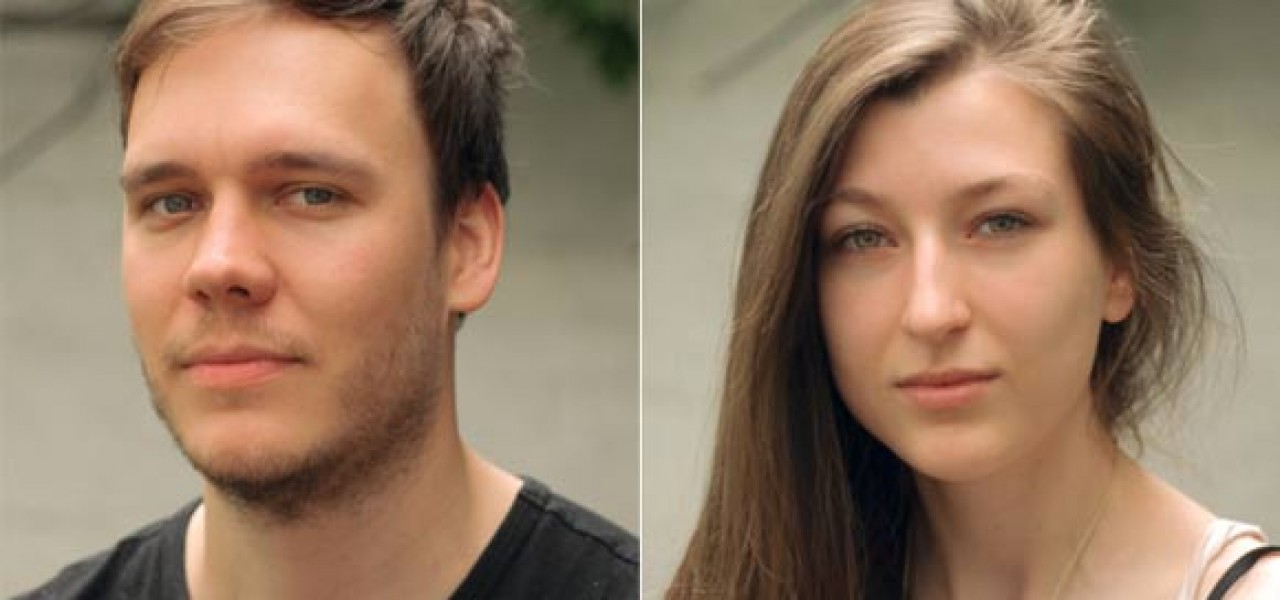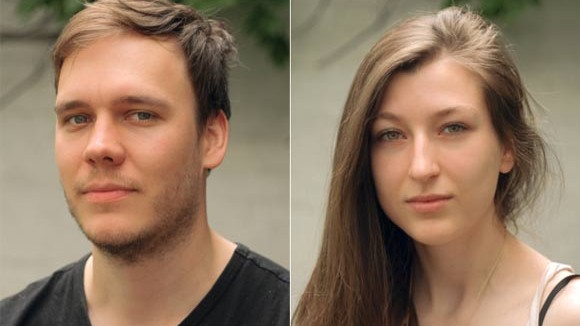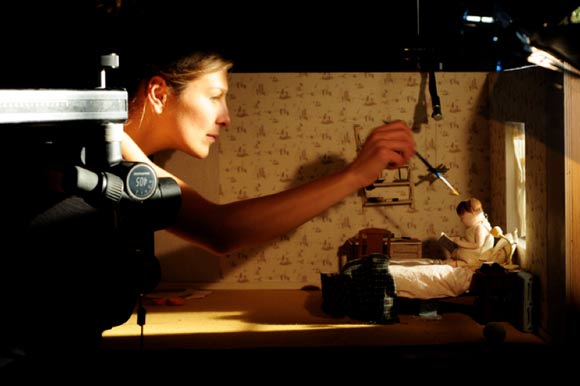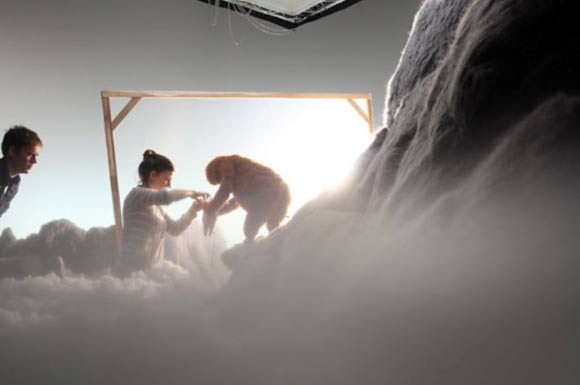

Q&A: ‘Oh Willy…’ Directors Marc James Roels and Emma De Swaef On Being Indie Filmmakers
Marc James Roels and Emma De Swaef are an animation duo from Ghent, Belgium. Their work has gained extensive notoriety in the past few years, after their 17-minute wool-animated short Oh Willy… swept the festival circuit and charmed the hearts of audiences across the globe, while launching a mini-trend of animating with wool. During my JAPIC Animation Artist-in-Residence tour in Tokyo, I was able to witness their filmmaking process in its early stages. They approach their narratives seriously, honestly, and with light hearts. The bonds they form with their creations are very real, and terribly charming. Marc (and Emma) were kind enough to share some of their thoughts about working as both commercial and independent artists, the unique challenges of working with unconventional materials, and the importance of storytelling.
CARTOON BREW: So, you two are living the life of an animation couple. Who does what, in terms of filmmaking dynamics?
Marc James Roels: Yes, we’re living the dream! We’ve never really discussed it specifically in terms of who does what. Our working dynamic seems to naturally follow through from our personal relationship. Emma gets right down to the business of actually making and producing stuff; she’s very pragmatic that way. I, on the other hand, am so cack-handed and dumb that I wouldn’t trust myself with a pair of child-safe scissors so I mostly stick to writing and storyboarding. On set we delegate the animation to a small team while Emma and I take care of setting up and lighting the sets. I try to make up for all my complaining and anxiety during pre-production by doing most of the grunt work in post-production.
CARTOON BREW: How do you survive as filmmakers? What’s your balance between personal and commercial work?
Marc James Roels: For commercials we’re represented by a few production companies worldwide, so up until now we’ve usually done one or two ads a year, although we’re not too sure how long that will last. Ad agency meetings are usually intensely awkward affairs and we’re really not very good at feigning enthusiasm. There are very few agencies we feel comfortable working with so we can’t rely too heavily on doing ads to survive. We’ve done some art direction and prop-making on a couple of commercials for other directors who we know and trust, but we’ve generally found that our personal work has opened up many more doors to new opportunities than having regular commercial work. On the other hand working on commercials has helped us discover new techniques and means that we end up using in our personal films so we do try to strike that balance.
CARTOON BREW: You’ve done amazing things with wool as a medium for animation. How did you end up appropriating it into your films? Can you share some knowledge of what you’ve learned while working with the soft material, both struggles and triumphs?
Marc James Roels: Well, unlike most people Emma grew up on a farm surrounded by sheep. She was knitting, sewing and making dolls and puppets from a very young age. So in terms of using wool and textiles in our films, it wasn’t an idea we suddenly hit upon out of the blue as something unique and different from the traditional materials used in stop-motion. We saw it more as a readily available material that Emma had experience working with.
We started using wool as a material while Emma was studying documentary filmmaking. She came up with the idea of integrating animated portions into her documentaries using knitted puppets with the idea of creating a tension between the narrative and the style. Emma had little experience making armatures so these first characters were very crude. But we liked the way light reacted to wool and we found we could create a consistency in the style so we just kept coming back to it.
As far as struggling with the material, it’s true, wool really isn’t the easiest material to work with. It constantly moves, it fluctuates with temperature changes and having characters covered in felt makes them very inflexible so we’ve had to continually plan and write our films in function of their inflexibilities. The restraint in the mise-en-scene is largely due to that. Even the simplest actions end up being nightmarish to animate so we’ve constantly had to rethink and rewrite our films which in the end always seems to be a good thing.
CARTOON BREW: The photography in Oh Willy… was really refreshing to see in a stop motion film. The lighting and cinematography was very well executed. What were some of the processes behind designing the shots?
Marc James Roels: Our only experience with cinematography up until making animated films had been on live-action sets directing short films, so we never felt we were trying to do anything stylistically different. Perhaps we’re ignorant of the possibilities afforded in animation, but we basically just try to make things look as naturalistic and immersive as possible. The camera is never going to do anything zany or physically impossible; the lighting is only ever going to be either a stand-in for the sun or a practical lighting source within the scene.
We design each shot almost as if we’re a miniature crew on the set filming a documentary, keeping in mind that there could be elements on the set that would get in the way like walls, furniture, and trees, and using these to shape a scene. We’re actually not doing anything different from, say, what Ray Harryhausen was doing back in the day. Likewise we tend to avoid using computer-generated imagery. For instance, the fog towards the end of Oh Willy… was created by strapping wool over the lens. We also didn’t use any greenscreen compositing so everything in frame is actually present during the animation, and I could light everything accordingly. People are usually disappointed to hear that the lighting didn’t involve much more than taking a lamp or two and moving them around until things started looking good, which isn’t to say that it was easy, just that there are no secrets really.

CARTOON BREW: There’s a strong sense of realism behind the movements and personalities of your puppet characters. Even though the situations they find themselves in may be out of the ordinary, and at times fantastical, they react in a way that allows an audience to emotionally relate. Can you elaborate on what goes into designing your puppets, and figuring out their identities?
Marc James Roels: In terms of character design, the experience of making documentaries led us to come across many fascinating people so a lot of the characters, and especially the character of Willy in Oh Willy…, can be traced back to an actual person. Most of our character ideas now are based on stuff we come across doing research—characters from books, illustrations, photos, paintings, that kind of thing. We tend to steer clear of wacky, cartoonish characters and situations so when something out of the ordinary does occur it has more of an impact. We find the banal details of life rendered in a miniaturized stop motion setting to be far more affecting than the weird, fantastical elements in our films.

CARTOON BREW: I know that writing is a really important step in your filmmaking process. Can you verbalize why?
Marc James Roels: It’s not an original notion, but no matter how bad a film looks or is ‘badly’ animated, the writing can turn that all around. An audience seems to respond much more deeply to a compelling idea or story than to spectacular, attractive-looking visuals. We spend far more time writing than we do animating or constructing, and we constantly keep rethinking all the sequences while we are shooting, based on what the sets really look like and what the puppets can do.
CARTOON BREW: The funding rout you took with Oh Willy… seems pretty complicated, with production taking place in several different countries. Do you mind sharing a little bit on how that was executed?
Marc James Roels: We split the film production of Oh Willy… over three countries: France, Belgium and the Netherlands for pre-production, production, and post-production, respectively, with the main production being handled by Beast Animation in Belgium. Many European countries offer grants to filmmakers that they can apply for through a production company. The amounts vary, and obviously each government wants a certain amount of the work to be carried out by people from their respective country. To make up a total budget for a film, we need to approach various organizations and production companies from different countries, and for this reason production needs to move from country to country. It is complicated, but then I can’t think of many means of getting money to do a film that aren’t complicated. It affords filmmakers the opportunity to make films outside of a commercial field and to really forge their own personalities and identities as artists. We’re actually very fortunate to have such a system in place.
CARTOON BREW: What was the inspiration behind the short festival intro film Fight!?
Marc James Roels: During our artist residency in Tokyo we found ourselves (as you well know Caleb) fascinated by the Sumo wrestling on the local TV. Emma started sketching these matches. We then had the chance to see a wrestling match live at a stadium, which went beyond all expectation. At one point, two of the wrestlers, sworn enemies, still drenched in blood, embraced each other and announced their undying friendship and that they would be forming a team together. We thought this was such a weird and hilarious scene that it stuck with us, and the festival intro seemed like a good opportunity to do something with it.
CARTOON BREW: It’s been about a year since we last saw each other in Japan. Are there any big developments that you two would like to share about what you were working on during the JAPIC residency?
Marc James Roels: We finally managed to finish a short one-minute film that we were commissioned to make as part of a group of films commemorating World War I, which I believe will be doing the rounds at a few festivals this year. Right now we’re in the midst of the complicated procedure of financing our next film. We can’t say too much now, but we’re pretty excited about it.
CARTOON BREW: Before we end, can you both share some of your top influences within animation?
Marc James Roels: Suzie Templeton especially Dog, Igor Kovalyov’s short films, Johannes Nyholm’s Dockpojken, Wes Anderson’s Fantastic Mr. Fox, Stéphane Aubier & Vincent Patar’s A Town called Panic, David OReilly’s wit, charisma and oeuvre.

.png)